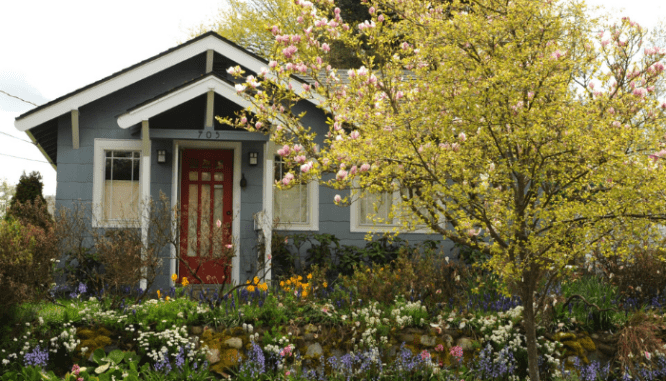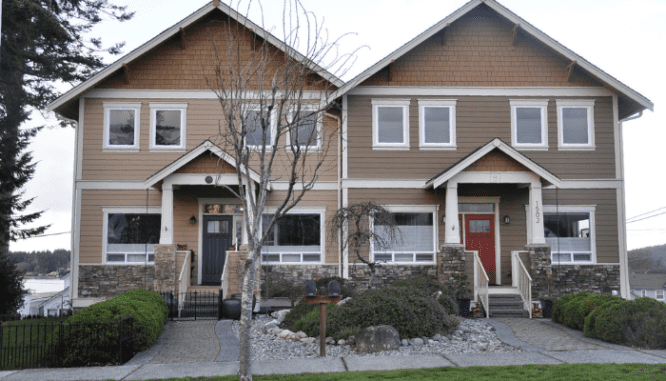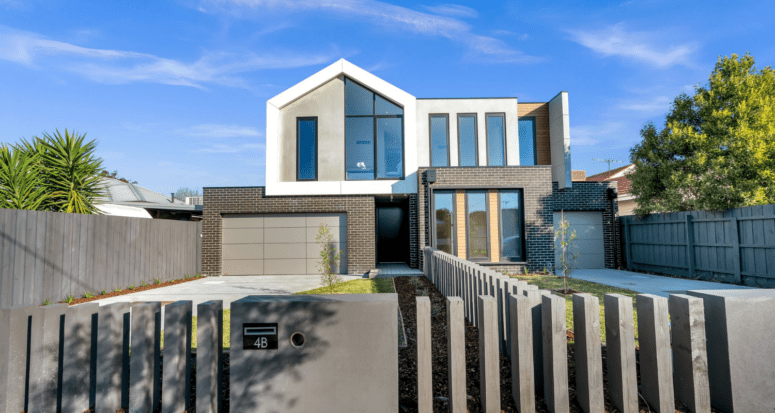A Guide to Real Estate Investment for Anyone (Yes, Even You!)
- Published on
- 18 min read
-
 Chelsea Levinson Contributing AuthorClose
Chelsea Levinson Contributing AuthorClose Chelsea Levinson Contributing Author
Chelsea Levinson Contributing AuthorChelsea Levinson, JD, is an award-winning content creator and multimedia storyteller with more than a decade of experience. She has created content for some of the world’s most recognizable brands and media companies, including Bank of America, Vox, Comcast, AOL, State Farm Insurance, PBS, Delta Air Lines, Huffington Post, H&R Block and more. She has expertise in mortgage, real estate, personal finance, law and policy.
Ahh, real estate investing — it sounds like The Dream, doesn’t it? You picture yourself retiring early, living in a sleepy beachside town while your investments rake in passive income far greater than what you ever made at your day job.
But how do you get there?
First, the bad news: You should probably understand that real estate investing isn’t quite as passive as it’s made out to be. There’s a lot of skill, knowledge, work, and timing involved, though you can make money over time — including passive income — if you’re smart.
Ready for some good news? Regular buyers just like you can totally get into real estate investing, with a little know-how. That’s where we come in!
We did the research and talked to Rosemary Mancuso, a top Massachusetts agent who helps her everyday clients invest in real estate. She walked us through everything you need to know to get started. So let’s jump into it!

Is real estate even a good investment?
The short answer: Yes, according to experts, real estate tends to be a good investment, provided you’re not trying to profit in the short term.
“Real estate [investment] is over time,” explains Mancuso. “So as long as you’re holding onto it over time, it’s a great investment.”
She cautions that markets can change every six months, but over the longer term — anywhere between three and 10 years or even longer — that’s where most people make their real estate money.
According to Mancuso, buyers should focus on slow and steady appreciation over cashing in quickly.
“I’ve never had anyone that’s bought a multi-family or a piece of property 10 years ago and said that it was a mistake,” she shares.
Real estate investing vs. other types of investing
“Okay, but how does real estate stack up against other types of investments?” you might be wondering. Unfortunately, the answer to that question isn’t so straightforward.
Each type of investment has its own unique pros and cons, and your bottom line can be affected by a range of economic factors, many outside your control.
Investing in stocks is volatile, though big risks can bring big rewards — if you get your timing just right. Stocks also tend to be more liquid, so you can cash out when you need to access your money.
The downside to investing in stocks? You can lose all you’ve invested in a flash, especially if you don’t know what you’re doing.
Real estate, on the other hand, is more of a slow burn, earning you money over time. And it’s much harder to access any cash you’ve invested unless you sell or refinance the property first.
So which investment path is right for you? Honestly, it depends! Each person’s financial situation and goals are unique.
But one thing we can say when it comes to investing your money: It’s generally not a good idea to put all your eggs in one basket, and it’s always a good idea to consult a trusted financial adviser before committing to anything.

7 top reasons why real estate is a good investment
Not quite convinced? Here are seven big reasons real estate makes a great investment if you approach it the right way.
1. Real estate is a tangible asset …
Real estate is a physical, tangible asset that will always have some value. There’s a finite amount of property available, and owning that property means you have something of real value.
With stocks, your investment can evaporate into nothing overnight. With real estate, your property value can decrease, but it’s unlikely to become entirely worthless.
2. … That typically increases in value over time
In the U.S., homes tend to appreciate an average of 3.9% each year, though that number can be higher or lower depending on the individual market and its conditions.
For buyers who are interested in purchasing a home to rent it out, there’s even more good news: Single-family rental homes offer annual returns of roughly 9%, a very strong number for any investment.
Though note that larger market swings in either direction can and do happen.
For example, during the Great Recession, home prices fell 13.9%, leaving many homeowners underwater on their mortgages (in other words, owing more than the home is worth).
Another example that’s far less disheartening? Between 2020 and 2021, U.S. homes appreciated a whopping 14.5% thanks to high demand and one of the strongest seller’s markets in history.
These swings are outside the norm, but they’re something to keep in mind as you contemplate investing in real estate.
The bottom line: You can expect your real estate investment to appreciate over time, but you may need to ride out some unpredictable market swings in the meantime.
3. You can always add to a home’s value
When you own a property, you can always increase its value with improvements made over months and years.
Even simple tasks like painting, upgrading hardware and fixtures, and putting in energy efficient appliances can raise the value of your property.
4. Equity is your friend
As you pay off your mortgage, you gain equity (that’s the portion of the home you own as opposed to what you still owe your lender) in your investment. This builds your wealth over time. And if you ever need to access that money down the road, you can leverage it through a home equity loan or line of credit.
5. Earn passive income
Renting out a home can be a great way to earn passive income, as long as you price the rent smartly, take care of routine maintenance, and find someone trustworthy to help manage the property.
6. Enjoy tax breaks
Property ownership comes with tax breaks. You can deduct the mortgage interest from your home, and even state and city property taxes (depending on your location). If you have an investment property, you can usually deduct the expenses and operating costs associated with renting it out.
Plus, capital gains taxes are lower on properties than they are on other investments, and you can often defer paying capital gains taxes if you reinvest the proceeds from the sale of one property into buying another.
7. You don’t need to invest much upfront
Even if you’re not ready to purchase an investment property or manage a rental, there are plenty of income-generating options available. Some allow you to get started with as little as $25. More on these lower-cost investments soon!

Top 7 ways to get started in real estate investing
Whether you buy your own primary residence, purchase a multi-family home, or put your money in online investing platforms, acquiring wealth through real estate investing could be more accessible than you think.
Here are seven ways to go about it.
1. Buy a multi-family property
If you can qualify for the mortgage loan, a multi-family property can be a great way to invest in real estate.
“You can actually have one side rented out, and they can pay a good amount of your mortgage,” reveals Mancuso.
Some multi-family properties can have up to four units, increasing your revenue potential. Eventually, you may even be able to sell the units separately for an even bigger return on investment.
2. Get a roommate
“For [investment] beginners, a lot of people have roommates,” Mancuso shares.
“If you’re looking to buy a single-family home, and you’re up for a roommate, that might be a great idea to rent out a room to someone you know.”
This can help cover a portion of your mortgage, and perhaps even give you some much-needed company.
3. Try a short-term rental
Have some extra space — maybe a finished basement, in-law suite, or bonus room with an attached bath? That square footage could be paying you in the form of a short-term rental.
Use sites like Airbnb to list your space — the proceeds might be more than you realize, especially if you live near a popular tourist destination.
Short-term rentals can be a great income stream because they typically earn a higher nightly rate than what you’d get for a longer-term rental.
However, Mancuso suggests living in the home for at least a year to feel things out before trying this strategy out. That will give you time to figure out the ebb and flow of life in your new home, and decide how (or if) you’d like to proceed with your rental.
4. Or perhaps a longer-term rental
Maybe you don’t want to deal with new guests constantly coming in and out of your home, but you’re still interested in bringing in rental income. If that sounds like you, a longer-term rental might be the ticket.
Whether you decide to rent out a portion of your home, or the whole thing while you travel the country living out your dream of #vanlife, a longer-term rental can bring income stability and peace of mind.
Plus, you only have to worry about vetting one tenant, rather than new vacationers every few days.
If you’re unsure of where to look for a property, Roofstock pre-vets single-family investment rental homes for you, removing a lot of the risk and upfront work.
One caveat: If you do plan to be on the road far away from your property, you’ll likely need a property manager to help maintain the home and respond to the needs of your tenant while you’re away.
5. The tried-and-true buy-and-hold
Not sure if you’re up for living with roommates or opening up your home to strangers? That’s totally fair! One investment strategy you can take is to do nothing, also known as the buy-and-hold. That’s when you keep a property for years and pay down the mortgage while it appreciates in value.
Okay, maybe we exaggerated a bit when we said you could do nothing. You still need to maintain the property and make periodic improvements if you want to increase its value. If you actually do nothing and leave it to sit deteriorating for years, it’s probably not going to be worth very much when you try to cash in on your investment.
6. Are you up for flipping?
Flipping sounds simple: You just buy a house, fix it up, and sell it for a profit, right?
Not exactly. While flipping can be a good way to make money investing in real estate, you really need to know what you’re doing.
There’s a whole science to flipping. Experienced investors run all kinds of calculations on properties before they make flip purchases. They look at a range of factors, including:
- The price of the home
- The cost to make renovations
- The expense of holding the property for a period of time while repairs are made (this includes costs like mortgage payments, utilities, lawn maintenance, and so on)
- The home’s projected value on the market once repairs are finished (in the flipping world, this is called the after repair value, or ARV)
Most experienced investors won’t spend more than around 70% of a home’s ARV for a flip. That’s because at a certain point, it’s just not worth the time, energy, or expense if the profit margin isn’t there.
Keep in mind that top investors have years of experience running these calculations, and it’s going to be much more challenging for you to come up with realistic numbers.
Plus, even the pros get it wrong sometimes and make a poor bet on a flip. That may not be a big deal to an investor who buys hundreds of properties a year, but for a buyer who’s banking their one big investment on a flip, the results can be devastating. All of that is to say, flips are a risky and complex business!
So should you try flipping? That depends on how much work you’re willing to put in and who else you’ve got on your flip team. At a bare minimum, Mancuso suggests enlisting the help of a top agent, a real estate attorney, and plenty of construction and trade experts to help with renovations.
On top of having the right team, you’ll also need to know what to look for in a flip. Your agent can help you with this, but there are a few relevant factors to keep in mind: location, features, rooms, layout, home type and style, property size (larger properties cost most to landscape and maintain), the overall health of the local real estate market, and more.
You even need to think about the home’s era — also known as when it was built — and the relative pros and cons of houses constructed at that time.
“If you’re looking for flips, I always find the houses between the 1940s and 1960s are solid homes,” Mancuso reveals. “Mechanically, everything’s sound — the roof, the heating system, the windows. However, they might need to be updated with decor, stripping wallpaper, refinishing floors, and upgrading the kitchen.”
She adds that there are plenty of ways to upgrade a kitchen that won’t break the bank, including adding recessed lighting, a trendy backsplash, freshly painted cabinets and walls, updated hardware and fixtures, and new energy efficient appliances.
All of that is to say, flipping is not for the faint of heart. It’s a tough business with slim margins, and it’s typically best for those with a bit of experience under their belts.
7. Other types of investments
Not ready to buy an investment property, or even a home? There are still ways to get started investing in real estate for as little as $500 (or sometimes even less!). Here’s a brief, non-exhaustive list of ways you can dip your toes into real estate investing without purchasing a property:
- Online investing platforms allow you to invest in real estate for a relatively small sum. Depending on the platform, the minimum investment is typically anywhere between $25 and $1,000. Here are a few popular options:
- Other popular forms of passive real estate investment include:
- REITs (real estate investment trusts)
- Real estate mutual fund
- Real estate traded fund (EFT)
- Real estate investment group
- Private equity fund (Note: often requires a large upfront investment)
- Opportunity fund

How much money do you need to invest in real estate?
You don’t need to have millions in the bank to invest in real estate. You can start with as little as $25!
Granted, you’re not exactly going to get rich from a $25 investment, and that investment probably won’t pay off overnight.
Whatever you invest now should be a number you’re comfortable with. Let’s look at a few different tiered levels of investment and talk about what’s possible.
$25 to $1,000
Those aforementioned online investing platforms? They’re a great way to start small. Many require an upfront investment of at least $500, but a few go all the way down to $25. Most promise returns of anywhere between 6% and 12% annually.
Of course, success isn’t guaranteed. Investing in these platforms is akin to buying stocks, and you have no control over the outcome. Still, it’s an attractive option for many brand-new investors because it doesn’t require the upfront cost of buying an investment property.
The only problem? There are an overwhelming number of options, and it’s hard to navigate their relative strengths and weaknesses. Thankfully, there’s an app for that — BrickFunding compares the merits of each investment platform to help you choose the best option for you.
$1,000 to $5,000
If you’re willing to invest a bit more, you could try real estate investment trusts, or REITs. Basically, REITs purchase properties — they could be commercial or residential — and you invest in their property portfolio. Although you’re dealing with real property, investing in REITS is similar to purchasing stocks.
If you want actual part ownership of a group of properties, try real estate investment groups. They buy up or build groups of homes and sell them as rentals to investors. Then the investment group stays on to help manage the rentals and takes a cut of all future rents.
$5,000 to $10,000
Have $5,000 to invest in real estate? You’ve got options!
- Invest with a group of friends, pool your money, and make a down payment on a rental home. But make sure to create a contract where all responsibilities are clearly laid out!
- Add a small bathroom and/or kitchenette to a bonus space and rent it out on a short-term listing site.
- Try Roofstock, where you can become a fractional owner of a single-family home with a minimum investment of $5,000. They have a 30-day money-back guarantee and also guarantee a signed lease on the home within 45 days, or they’ll pay the rent for up to a year.
$10,000 or more
At this investment level, you may be able to start thinking about actually buying a property, whether a single-family residence for yourself (with a room rented out!), or a multi-family home, where you live in one unit and rent out the extra space.
If the home is your primary residence, you can typically get better terms on the mortgage:
- For an investment property that you aren’t going to live in, you’ll pay significantly higher interest rates, and you will need to put 20% to 25% down.
- For a primary residence, you’ll get lower rates, and depending on your circumstances, you may be able to put down as little as 3% on a conventional loan or 3.5% with an FHA loan.
Dip your toes in with a condo
If a multifamily or even a single-family home is out of your reach, Mancuso says a condo can be a great starter investment.
“It’s really all about starting small,” she insists. “I’ve seen a buyer start off small and they get a condo. That condo then turns into another purchase of a single-family home. They might keep that condo and rent it out because they’ve paid it down.”
Another perk of condos? Most of the exterior maintenance is covered by the COA (a condo’s version of an HOA), which is especially helpful when you’re renting out a home. Just make sure to check your COA bylaws, because they often have rules about renting your unit out.
“You’re able to rent that condo out for great money — more than what you’re actually paying for the mortgage with these low interest rates — and you’re ready to make your next move,” Mancuso adds.

3 simple steps to get started
By now, you’re thinking this real estate investment thing sounds great, and you’re ready to get started. You’ve got some ideas about where you could put your money, and you’re feeling confident you can handle the commitment.
Great! Here’s your simple three-step plan.
1. Find the right team
When it comes to real estate investing, having the right team is everything. Here are a few experts you’ll want by your side:
- Top buyer’s agent with investment experience to help you buy a property (BONUS: they’ll give you a list of their own trusted vendors to build out your team)
- Real estate attorney to look out for your legal interests
- Financial advisor to help you plan out investments
- CPA to assist with taxes
- A good title/closing company to protect your claim to the title
- Home inspector to give you an honest assessment of the property’s repair needs
- Trusted lender to safely finance the property
- Quality tradespeople to make any necessary repairs or renovations
- Property manager to handle rentals if you can’t personally
Of course, if you’re merely investing a couple bucks on an online investing platform, you probably don’t need a massive real estate team at the ready (though it can never hurt to consult a trusted financial advisor).
2. Create your investment strategy
Work with your team to create the perfect investment strategy.
Your real estate agent and financial advisor will be key players here. They’ll help you figure out your best path to wealth-building for your unique circumstances.
For example, maybe you already work two jobs and can’t be bothered to fix up and rent out a home. In that case, capital investments might work better. Conversely, if you’ve got a good amount of cash saved and some time on your hands, you may be up for the challenge of a fixer-upper rental investment.
3. Make your move
You’ve done the work, studied your options, and you’re ready to make your investment(s). Congratulations — you’re now a real estate investor. Here’s hoping the profits roll in!
Step up your game once you’re more skilled
One cool thing about real estate investing is there are always new ways you can grow and branch out.
- You could deepen your knowledge of the local markets, and study the best places to buy rental properties.
- You can try your hand at foreclosure investing.
- Or maybe you’re finally ready to buy an investment house to fix-and-flip or buy-and-hold.
- Finally, you can brush up on best practices for becoming a landlord if you plan to go that route.
How real people make money investing in real estate
If all of this hasn’t convinced you that real estate investing can work for real, everyday people, we don’t know what will. But if you need a little more nudging, look no further than these real normal people’s investment stories.
Chris G. held onto a property, rented it through some rough financial circumstances, and came out the other side $48,000 richer for it.
Andre Albritton had a miss when he first invested in REITs, but recently had an investment that returned a solid 30%.
Elisa Covington started small with a fixer-upper she bought on a short sale, and leveraged that purchase into a small flipping empire. So far, she’s flipped over 20 homes, and only lost money on one of them.
Another buyer bought a primary residence that was below their means so they could purchase two additional investment properties — one rental, one fix-and-flip — that eventually got them into their dream home.
If these people can do it, so can you!
With a little knowledge, a lot of patience, and the right team by your side, you’re ready to get started investing in real estate. Happy beach retirement!
Header Image Source: (R ARCHITECTURE / Unsplash)
